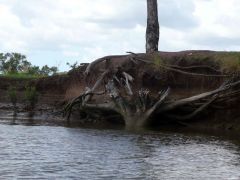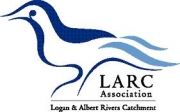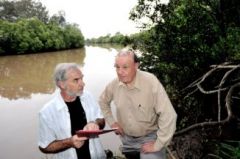
Logan and Albert Conservation Association

Local newspaper Jimboomba Times is now available online and have reported on this environmental isue here.
Senior member of the Healthy Waterways scientific expert panel Professor Rod Connolly presented the results to the southern region audience at the Gold Coast.
"With Logan we saw a slight improvement which came from a slight reduction in the levels of sediment and nutrients in the river," he said.
"The message for Logan is that what council and landowners are doing is excellent but we need to be working harder on two things.
"The first is the need for better processes in the development of greenfield sites, if we want healthy waterways we need to prevent sediment from escaping into our rivers.
"The second thing refers to rural areas where we are seeing a change from pastoral activity to all sorts of other land uses and again we need to ensure the sediment created by this change does not make it into the river.
"Planting bankside vegetation is one way of doing this but it is important for both council and landowners to take responsibility.
"Council's recent investment in sewerage treatment plant upgrades has been one of the most significant factors in improving the health of its waterways and hopefully it will result in further improvements."
Professor Connolly said he had considered the Albert Catchment to be in reasonably good condition but that the drop from an A- to a B- was a surprise.
"This is a meaningful decrease but at this point I couldn't jump in and say what the causes are," he said.
"We need to do more detective work to find out what has gone wrong before we can go down that route.
"Overall I would like to see more investment in waterways and we need to look at the new bulk water authorities to contribute a large fraction of the pie.
"More support for landowners and catchment groups would also be welcome."
Asked what impact new urban cities at Yarrabilba and Flagstone might have, Professor Connolly said as long as Water Sensitive Urban Design (WSUD) principals were followed, there was no need for a negative impact on waterways.
"The history of south-east-Queensland shows that when you have substantial number of people moving to new developments there is a decrease in the health of the streams and estuaries," he said.
"There are things that can be one to prevent this however and it just depends on how much the community wants to dedicate to the health of our waterways."
Senior member of the Healthy Waterways scientific expert panel Professor Rod Connolly presented the results to the southern region audience at the Gold Coast.
“With Logan we saw a slight improvement which came from a slight reduction in the levels of sediment and nutrients in the river,” he said.
“The message for Logan is that what council and landowners are doing is excellent but we need to be working harder on two things.
“The first is the need for better processes in the development of greenfield sites, if we want healthy waterways we need to prevent sediment from escaping into our rivers.
“The second thing refers to rural areas where we are seeing a change from pastoral activity to all sorts of other land uses and again we need to ensure the sediment created by this change does not make it into the river.
“Planting bankside vegetation is one way of doing this but it is important for both council and landowners to take responsibility.
“Council’s recent investment in sewerage treatment plant upgrades has been one of the most significant factors in improving the health of its waterways and hopefully it will result in further improvements.”
Professor Connolly said he had considered the Albert Catchment to be in reasonably good condition but that the drop from an A- to a B- was a surprise.
“This is a meaningful decrease but at this point I couldn’t jump in and say what the causes are,” he said.
“We need to do more detective work to find out what has gone wrong before we can go down that route.
“Overall I would like to see more investment in waterways and we need to look at the new bulk water authorities to contribute a large fraction of the pie.
“More support for landowners and catchment groups would also be welcome.”
Asked what impact new urban cities at Yarrabilba and Flagstone might have, Professor Connolly said as long as Water Sensitive Urban Design (WSUD) principals were followed, there was no need for a negative impact on waterways.
“The history of south-east-Queensland shows that when you have substantial number of people moving to new developments there is a decrease in the health of the streams and estuaries,” he said.
“There are things that can be one to prevent this however and it just depends on how much the community wants to dedicate to the health of our waterways.”

Following the release on Wednesday November 20 of the Healthy Waterways Ecosystem Health Report, in which the Albert and Logan Rivers each received fails for the second year in a row, general agreement has emerged within LACA and among other conservation groups across the region that the situation for this river/bay system is now critical and requires urgent new attention, NOT business as usual.
Continuation alone of the strategies put in place by SEQ Catchments and Healthy Waterways and responsible NRMs clearly will not provide the genuine on the ground, full system solutions that are now desperately needed. Their strategies, while clearly aimed at long term outcomes, have nevertheless been in place for ten years during which the rivers and bay areas in SE Qld have steadily declined, with the Logan/Albert/Southern Bay the worst performing system in
The need for a ‘Crisis
LACA members and others have expressed the view that urgent action is needed at a government/legislative level. To explore this and hopefully arrive at a collective decision, a ‘crisis summit’ on the rivers and bay has been proposed, to be held possibly in February 2011. As a ‘summit’ this will differ from the Logan City Council proposal for a ‘forum’. While a ‘forum’ usually involves open community access and input of ideas ending in a summary report, a ‘summit’ involves the key players and decision makers in a process of dialogue and collective decision making for action. However, the summit could take on board the information that might flow out of an earlier ‘forum’, so the two proposals are not necessarily mutually exclusive.
This issue encompasses the whole catchment area of the Logan and Albert Rivers, and as such includes the impacts on the system of major new development proposals including those at Flagstone, Yarrabilba, Bahrs Scrub and Bromelton. Accordingly, a ‘crisis summit’ would involve key decision makers from Federal, State and local government, landholders groups, Agforce, conservation groups, developers in the region, river based industry groups such as prawn farmers, tourism and amateur and professional fishing organisations. The starting point for the crisis summit should be the collective understanding that there is a ‘crisis’ in this system and that genuine new actions, possibly involving legislation, are needed in order to prevent the ecological and physical collapse of the river/bay system.
 Last call for volunteers as catchment crisis deepens
Last call for volunteers as catchment crisis deepens
In the wake of the 'fail' report cards for the Logan Estuary and the Southern Bay, the Logan-Albert Rivers Catchment Association (LARC) is also heading for a 'fail' if a new executive cannot be found at its forthcoming AGM. LARC is the peak organisation that speaks for and works to improve the health of the Logan-Albert catchment that drains into the failing Logan Estuary and Southern Bay.
 Logan / Albert / Southern Moreton Bay: Two fails in a row:
Logan / Albert / Southern Moreton Bay: Two fails in a row:
three strikes and you’re out?
The
The Logan / Albert Rivers and Southern Bay situation are worth so much to the State and the nation in a healthy condition that preventing an ecological shut down of the system must now be seen by the State Government as a ‘matter of State interest’.
Current international trends, highlighted by the recent Conference of the Parties to the Convention on Biological Diversity (COP-10) that concluded on October 29 in Nagoya, Japan, place increased imperatives on nations to adopt measures which incorporate the economic value of ecosystem services.
Queensland's ‘wild rivers’ legislation, which effectively frames the rivers as ‘biodiversity infrastructure’ whose systems, just like those of a road for example, must be made functional for the whole to begin to work is an exemplary model. It is possible that PES (payment for ecosystem services) could be applied to legislation to protect riparian areas, giving landholders cost neutral outcomes for productivity losses, fencing, revegetation etc.
We need to complement (or replace as necessary) the existing strategies with new whole-of-system initiatives over the next decade.
Read some coverage here in local news where several conservation group executive members express our concern.
"We are presiding over the final stages [of death] of a once healthy, productive and magnificent river system" said Barry Fitzpatrick. Unless we ensure that our river systems and bay are returned to a healthy functioning ecosystem, future health and wellbeing of the region is in jeapardy.